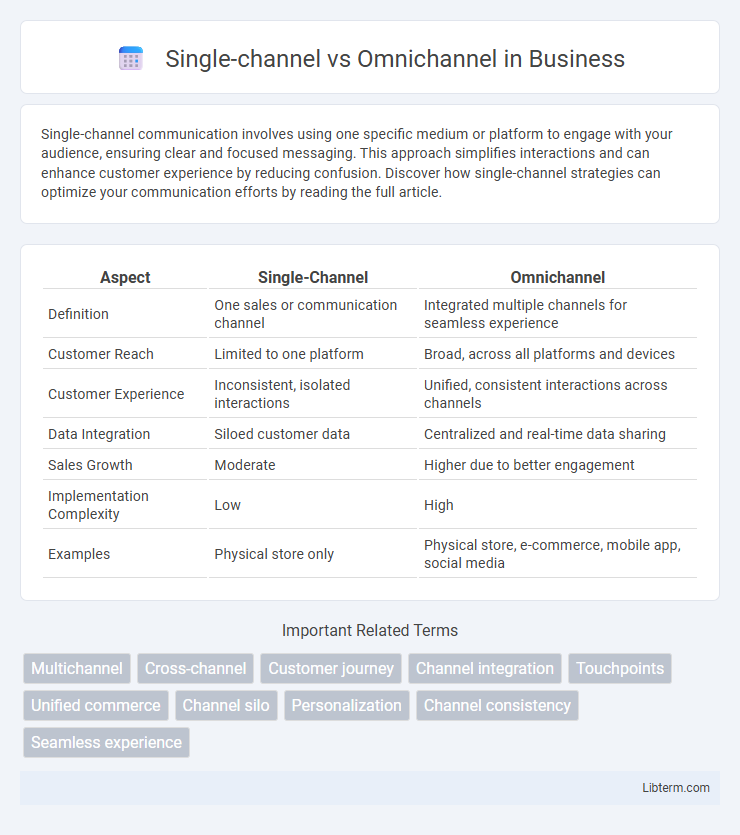Single-channel communication involves using one specific medium or platform to engage with your audience, ensuring clear and focused messaging. This approach simplifies interactions and can enhance customer experience by reducing confusion. Discover how single-channel strategies can optimize your communication efforts by reading the full article.
Table of Comparison
| Aspect | Single-Channel | Omnichannel |
|---|---|---|
| Definition | One sales or communication channel | Integrated multiple channels for seamless experience |
| Customer Reach | Limited to one platform | Broad, across all platforms and devices |
| Customer Experience | Inconsistent, isolated interactions | Unified, consistent interactions across channels |
| Data Integration | Siloed customer data | Centralized and real-time data sharing |
| Sales Growth | Moderate | Higher due to better engagement |
| Implementation Complexity | Low | High |
| Examples | Physical store only | Physical store, e-commerce, mobile app, social media |
Introduction to Customer Interaction Channels
Single-channel customer interaction relies solely on one platform, such as a physical store or a website, limiting customer touchpoints and engagement opportunities. Omnichannel integrates multiple interaction channels, including social media, email, mobile apps, and in-store experiences, creating a seamless and consistent customer journey across all platforms. This multi-platform approach enhances customer satisfaction by providing tailored communication and real-time support regardless of the channel used.
Defining Single-Channel Approach
The single-channel approach involves interacting with customers through one primary platform, such as a physical store or an online website, focusing on delivering a consistent experience within that channel. This method simplifies management and allows businesses to optimize operations specific to the chosen channel but limits customer touchpoints. Companies using a single-channel strategy often face challenges in providing seamless customer journeys compared to omnichannel methods, which integrate multiple platforms for a unified experience.
Understanding Omnichannel Strategy
Omnichannel strategy integrates multiple customer touchpoints such as physical stores, online platforms, mobile apps, and social media to deliver a seamless and consistent shopping experience across all channels. Unlike single-channel approaches that limit customer interaction to a single platform, omnichannel leverages data synchronization and real-time customer insights for personalized marketing and frictionless engagement. This strategy enhances customer loyalty, increases conversion rates, and drives higher revenue by meeting consumers wherever they prefer to shop.
Key Differences Between Single-Channel and Omnichannel
Single-channel strategies rely on a single point of customer interaction, such as a physical store or a website, limiting customer reach and engagement. Omnichannel integrates multiple touchpoints like mobile apps, social media, and brick-and-mortar stores, creating a unified and seamless customer experience. Customer data synchronization and real-time inventory updates distinguish omnichannel, enhancing personalized marketing and operational efficiency.
Benefits of Single-Channel Communication
Single-channel communication streamlines customer interactions through a single platform, enhancing consistency and reducing operational complexity. This approach simplifies tracking and managing customer data, leading to more focused and personalized service delivery. Businesses can achieve cost efficiency by investing resources into optimizing one channel rather than spreading efforts across multiple platforms.
Advantages of Omnichannel Engagement
Omnichannel engagement enhances customer experience by providing seamless interaction across multiple platforms such as social media, email, and in-store visits, increasing convenience and satisfaction. This approach collects richer customer data, enabling personalized marketing strategies that improve retention and boost sales. Businesses adopting omnichannel strategies typically see higher customer lifetime value and improved brand loyalty compared to single-channel methods.
Challenges of Single-Channel Adoption
Single-channel adoption limits customer reach by relying on a single platform, reducing opportunities for engagement and sales. This approach often results in inconsistent customer experiences due to fragmented data and insufficient touchpoints. Brands face challenges with scalability and adaptability, struggling to meet evolving consumer expectations in a digitally driven market.
Obstacles in Implementing Omnichannel Solutions
Implementing omnichannel solutions faces significant obstacles such as data integration challenges and inconsistent customer experiences across platforms. Companies struggle with synchronizing inventory, sales, and customer data in real-time, leading to fragmented service delivery. Legacy systems and high implementation costs further complicate the seamless execution of omnichannel strategies, limiting their effectiveness compared to single-channel approaches.
Choosing the Right Strategy for Your Business
Selecting the ideal strategy between single-channel and omnichannel depends on your business goals, target audience, and resources. Single-channel focuses on mastering one platform for a cohesive customer experience, while omnichannel integrates multiple touchpoints to provide seamless interactions across channels. Evaluate customer preferences, operational capacity, and long-term scalability to determine the most effective approach for maximizing engagement and sales.
Future Trends in Customer Channel Management
Future trends in customer channel management emphasize the shift from single-channel approaches to omnichannel strategies, integrating AI-driven personalization and real-time data analytics to enhance customer experience across touchpoints. Businesses adopting omnichannel platforms report increased customer engagement, with Gartner predicting that by 2025, 75% of organizations will adopt omnichannel customer service solutions. Emerging technologies like augmented reality, chatbots, and voice assistants further support seamless interactions, making omnichannel the standard for future customer relationship management.
Single-channel Infographic

 libterm.com
libterm.com